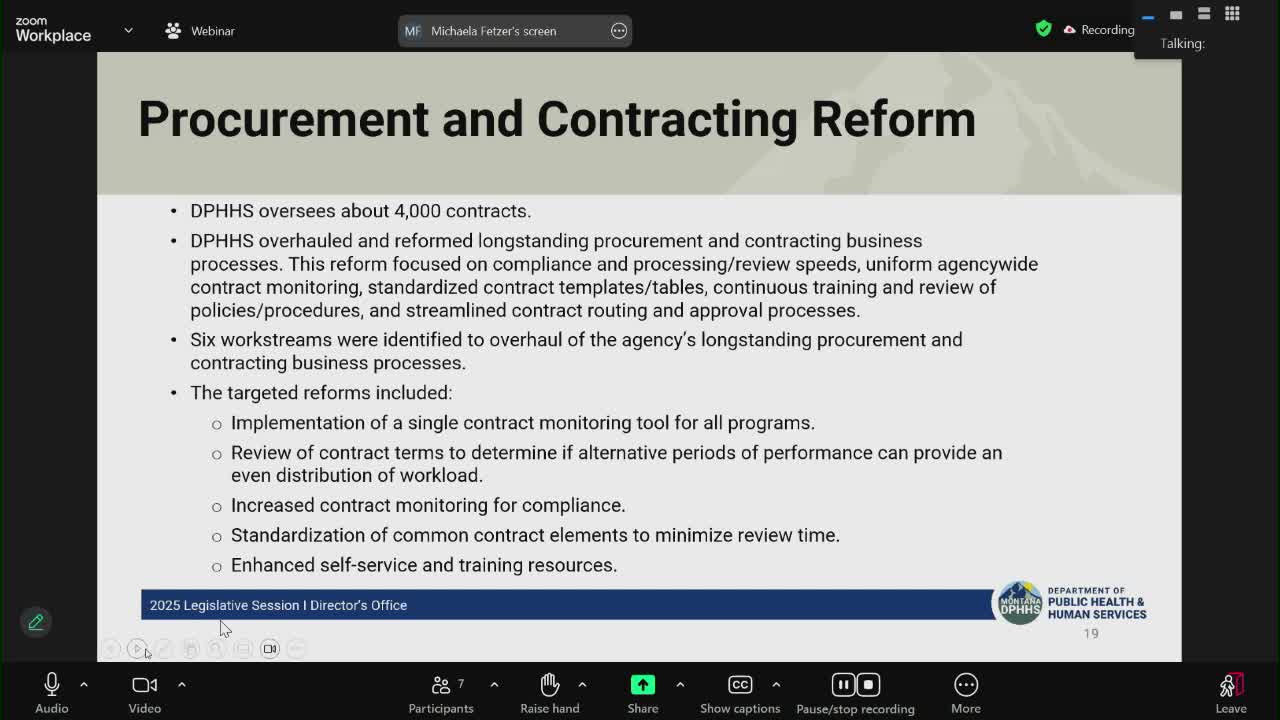DPHHS overhauls procurement, awards statewide TANF/SNAP employment contract to Maximus and asks for more legal staff
January 10, 2025 | 2025 Legislature MT, Montana
This article was created by AI summarizing key points discussed. AI makes mistakes, so for full details and context, please refer to the video of the full meeting. Please report any errors so we can fix them. Report an error »

DPHHS told the subcommittee it implemented a multi‑part procurement and contracting reform after a backlog of expiring and new contracts caused service disruption in 2023. The reform includes six work streams, a single contract monitoring tool, increased contract monitoring, standardized templates and efforts to reprocure large statewide services.
Kim Aiken, the department’s chief financial and operating officer, told the committee the department saw a surge in contract renewals and large ARPA‑ and initiative‑driven contracts that strained procurement and legal capacity. Aiken said the agency instituted six work streams to overhaul the process, centralized contract monitoring, standardized common contract terms, strengthened compliance monitoring and increased training for program staff.
As an example, DPHHS competitively procured a single statewide vendor to deliver TANF Pathways and SNAP Employment & Training services; the vendor Maximus is now live in Montana with about 20 service locations and a pay‑for‑performance element that ties payments to client outcomes, the director’s office said. The department described the procurement as intended to standardize case management and expand SNAP‑ENT access into counties that previously lacked services.
Legal review expanded agencywide: Paula Stannard, DPHHS chief legal counsel, told the committee the Department of Administration expects legal review of most contracts and that her office moved several attorneys to address contract workload. Because the change significantly increased attorney time devoted to contract review, DPHHS requested an additional staff attorney to the director’s office to maintain overall legal capacity elsewhere in the agency.
Ending: LFD and the department agreed to provide members an inventory of pending and recent procurements and contracts to help the subcommittee evaluate the staffing and funding request for procurement and legal support.
Kim Aiken, the department’s chief financial and operating officer, told the committee the department saw a surge in contract renewals and large ARPA‑ and initiative‑driven contracts that strained procurement and legal capacity. Aiken said the agency instituted six work streams to overhaul the process, centralized contract monitoring, standardized common contract terms, strengthened compliance monitoring and increased training for program staff.
As an example, DPHHS competitively procured a single statewide vendor to deliver TANF Pathways and SNAP Employment & Training services; the vendor Maximus is now live in Montana with about 20 service locations and a pay‑for‑performance element that ties payments to client outcomes, the director’s office said. The department described the procurement as intended to standardize case management and expand SNAP‑ENT access into counties that previously lacked services.
Legal review expanded agencywide: Paula Stannard, DPHHS chief legal counsel, told the committee the Department of Administration expects legal review of most contracts and that her office moved several attorneys to address contract workload. Because the change significantly increased attorney time devoted to contract review, DPHHS requested an additional staff attorney to the director’s office to maintain overall legal capacity elsewhere in the agency.
Ending: LFD and the department agreed to provide members an inventory of pending and recent procurements and contracts to help the subcommittee evaluate the staffing and funding request for procurement and legal support.
View full meeting
This article is based on a recent meeting—watch the full video and explore the complete transcript for deeper insights into the discussion.
View full meeting
